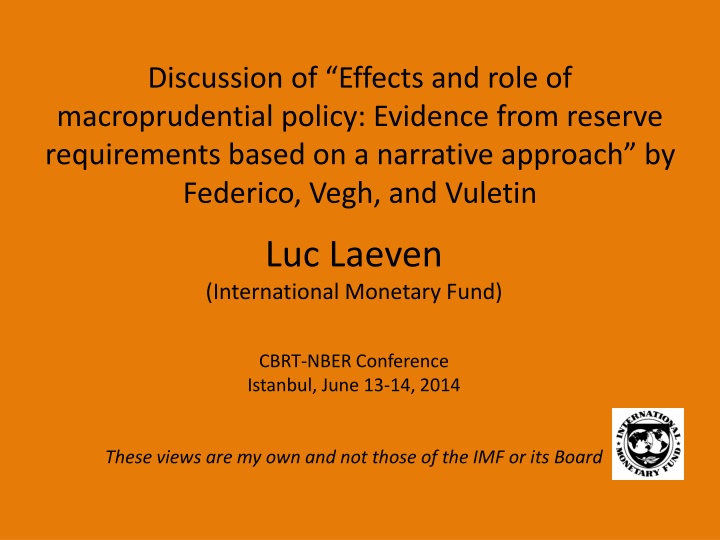
The Role of Macroprudential Policy in Emerging Economies
This paper explores the effects of reserve requirements on macroeconomic stability and their potential to act as a substitute for monetary policy in emerging economies. It highlights the importance of identifying exogenous changes in reserve requirements using a narrative approach and discusses the implications for credit growth and output stabilization.
Download Presentation

Please find below an Image/Link to download the presentation.
The content on the website is provided AS IS for your information and personal use only. It may not be sold, licensed, or shared on other websites without obtaining consent from the author. If you encounter any issues during the download, it is possible that the publisher has removed the file from their server.
You are allowed to download the files provided on this website for personal or commercial use, subject to the condition that they are used lawfully. All files are the property of their respective owners.
The content on the website is provided AS IS for your information and personal use only. It may not be sold, licensed, or shared on other websites without obtaining consent from the author.
E N D
Presentation Transcript
Discussion of Effects and role of macroprudential policy: Evidence from reserve requirements based on a narrative approach by Federico, Vegh, and Vuletin Luc Laeven (International Monetary Fund) CBRT-NBER Conference Istanbul, June 13-14, 2014 These views are my own and not those of the IMF or its Board
Summary of paper Empirical study of the macroeconomic effects of change in reserve requirements (RR) and monetary policy in four emerging economies (Argentina, Brazil, Columbia, and Uruguay) over the period 1992-2011 Finds that RR policy stabilizes output (easing of RR stimulates output), acting as a substitute for monetary policy, which is used to stabilize the exchange rate This is obtained only when appropriately identifying exogenous changes in RR using a narrative approach
Key contributions Collect detailed data on RR and use Romer-Romer (2004) narrative approach to classify to classify changes in RR into endogenous or exogenous to the business cycle RR traditionally seen as liquidity management tool to control money growth; here seen as substitute for monetary policy to control credit growth and output (countercyclical) Show empirically that RR can act as a substitute for conventional monetary policy in emerging markets that are subject to volatile capital flows
Comments Paper needs to give more institutional background and use this to guide analysis: exchange rate regimes, types of RR, and capital controls Related literature Long term and distributional effects Narrative approach as identification strategy Intermediate analysis of credit and capital flows
Institutional background (1) Exchange rate regimes changed over sample period For example, Brazil moved from fixed to floating in 1999 when introducing inflation targeting Effective reserve requirements<<statutory reserve requirements because they may be remunerated and subject to deductions, and banks may move into nondeposits such as repos (e.g. Robitaille (2011) for the case of Brazil)
Institutional Background (2) Some countries took other macroprudential measures to curb credit growth or mitigate the fallout from RR Brazil in 2008 offered FX swaps to firms rolling over FX debt, in 2010 introduced additional capital requirements on consumer lending, and in 2011 limits on short spot dollar (FX) positions, while Columbia (2001) and Uruguay (2007) introduced dynamic provisioning Some countries introduced capital controls over the sample period Brazil introduced financial transaction tax of 2% on foreign purchases of stocks and bonds in 2009; this was broadened and raised to 6% to 2010 to ease pressure on the exchange rate FX interventions For example, Brazil in summer 2013
Related literature Trilemma or dilemma (Rey 2013; Farhi- Werning, 2014) In Brazil, UIP does not hold since at least 2005 RR as macroprudential policy (IMF)
Long term and distributional effects VAR approach picks up long term output implications from changes in RR but not long- term effects of policy uncertainty Distributional consequences (e.g. RR may make it difficult for small firms to raise funds a la Forbes (2007)) RR could shift activity offshore and damage transparency
Narrative approach (1) Identifying assumption: monetary policy innovations have no contemporaneous effect on economic variables (output, employment, prices) VAR analysis generally obtains small effects of monetary policy Narrative approach allow to distinguish shocks that are endogenous and exogenous to the business cycle Narrative approach tends to find much bigger effect, in part because the Romer-Romer shocks are associated with much larger and longer changes in monetary policy than the VAR shocks (Coibion (2012))
Narrative approach (2) Application of narrative approach to macroprudential policy is challenging because less well documented and transparent (definition?) Exogenous changes in RR could still be endogenous to capital flows Application here is a bit of a black box Why not also apply to monetary policy? Need to distinguish at least between RR applicable to domestic currency and FX deposits; while correlation is high, effects could be markedly different Comparison with alternative approaches
Intermediate analysis Look at credit flows (that are directly affected by RR policy) and capital flows directly as intermediate step in the analysis
